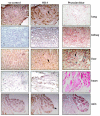Increase of HO-1 Expression in Critically Ill COVID-19 Patients Is Associated with Poor Prognosis and Outcome
- PMID: 35883791
- PMCID: PMC9311906
- DOI: 10.3390/antiox11071300
Increase of HO-1 Expression in Critically Ill COVID-19 Patients Is Associated with Poor Prognosis and Outcome
Abstract
Heme-oxygenase (HO)-1 is a cytoprotective enzyme with strong antioxidant and anti-apoptotic properties and previous reports have also emphasized the antiviral properties of HO-1, either directly or via induction of interferons. To investigate the potential role of HO-1 in patients with coronavirus disease 2019 (COVID-19), the present study assessed changes in HO-1 expression in whole blood and tissue samples. Upregulation of HO-1 protein was observed in lung, liver, and skin tissue independently of severe acute respiratory syndrome coronavirus 2 (SARS-CoV-2) presence. A significant increase of blood HO-1 mRNA levels was observed in critically ill COVID-19 patients compared to those in severe COVID-19 patients and healthy controls. This increase was accompanied by significantly elevated levels of serum ferritin and bilirubin in critically ill compared to patients with severe disease. Further grouping of patients in survivors and non-survivors revealed a significant increase of blood HO-1 mRNA levels in the later. Receiver operating characteristic (ROC) analysis for prediction of ICU admission and mortality yielded an AUC of 0.705 (p = 0.016) and 0.789 (p = 0.007) respectively indicating that HO-1 increase is associated with poor COVID-19 progression and outcome. The increase in HO-1 expression observed in critically ill COVID-19 patients could serve as a mechanism to counteract increased heme levels driving coagulation and thrombosis or as an induced protective mechanism.
Keywords: COVID-19; heme-oxygenase (HO-1); immune response.
Conflict of interest statement
The authors declare no conflict of interest.
Figures





References
-
- Wiesel P., Patel A.P., DiFonzo N., Marria P.B., Sim C.U., Pellacani A., Maemura K., LeBlanc B.W., Marino K., Doerschuk C.M., et al. Endotoxin-induced mortality is related to increased oxidative stress and end-organ dysfunction, not refractory hypotension, in heme oxygenase-1-deficient mice. Circulation. 2000;102:3015–3022. doi: 10.1161/01.CIR.102.24.3015. - DOI - PubMed
LinkOut - more resources
Full Text Sources
Miscellaneous

